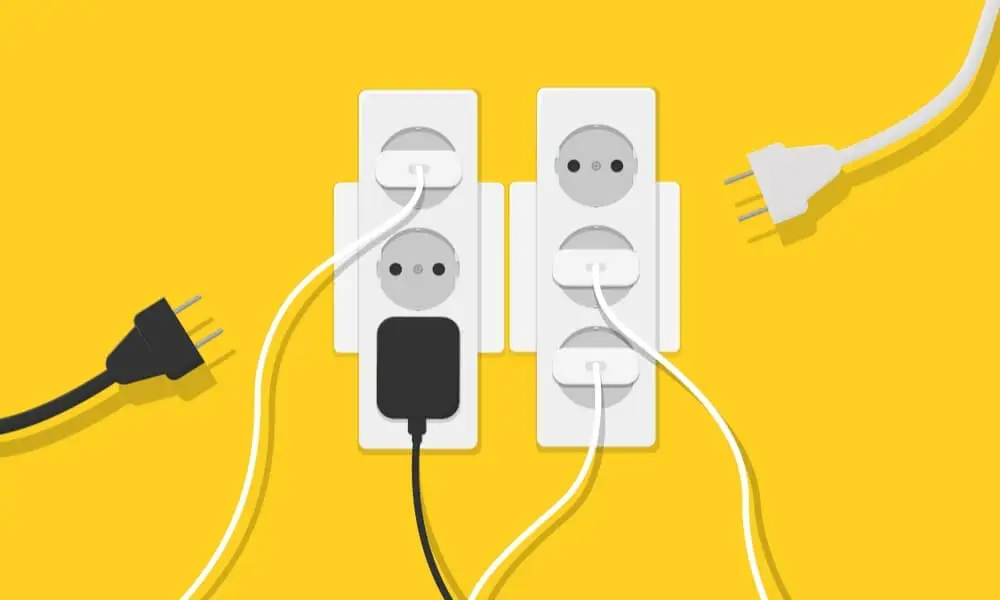Extension cords are incredibly convenient when you need to power appliances or devices in areas where outlets are out of reach. Whether you’re working on a DIY project, setting up outdoor decorations, or simply need to extend the reach of an electrical device, extension cords can be your best friend. However, it’s essential to prioritize safety when using extension cords to avoid electrical hazards and reduce the risk of fires.
This blog post provides 20 valuable tips for safely using extension cords. By following these guidelines, you can ensure that your electrical connections are secure, prevent accidents, and promote a safe environment for you, your loved ones, and your property.
We’ve covered you, from selecting the appropriate extension cord to understanding power ratings, inspecting cords for damage, and proper usage techniques. So let’s dive in and discover the key safety measures to remember when working with extension cords. Remember, a few simple precautions can make a significant difference in protecting yourself and your surroundings.
Extension Cord Hazards
Extension cords, while extremely useful, can also present several hazards if not used properly:
- Electrical Fires: Overloading an extension cord by plugging in appliances that draw more current than the cord can handle can cause the cord to overheat, potentially igniting a fire.
- Electrical Shocks: Damaged cords with exposed wires or using cords in wet areas can lead to electric shocks. Additionally, cords without a grounding wire can increase the risk of shocks.
- Tripping Hazards: Extension cords stretched across walkways or under carpets can create tripping hazards, potentially causing injury.
- Damage to Cord Insulation: Running cords through doorways, windows, or under heavy furniture can cause damage to the cord’s insulation, exposing the wires and creating a risk of shock or fire.
- Poor Connection: Partially inserted plugs or loose outlets can lead to poor electrical connections, causing arcing and overheating at the plug, which can be a fire hazard.
- Voltage Drop: Using an extension cord that is too long can cause a voltage drop, leading to inefficient operation of appliances and possibly damaging them.
- Exposure to Elements: Using an indoor-rated cord outside can expose it to weather conditions it’s not designed for, compromising its insulation and increasing the risk of electrical hazards.
- Child and Pet Hazards: Children or pets may play with or chew on extension cords, risking electric shock or damage to the cord.
- Daisy-Chaining: Connecting multiple extension cords can cause overheating, especially if the total length exceeds the cords’ capacity, increasing the fire risk.
- Improper Storage: Coiling cords too tightly or storing them in damp or hot areas can damage the insulation and internal wiring, increasing the risk of fire or shock when used again.
Understanding these hazards is essential for safe extension cord usage. It’s crucial to select the right type of cord for the application, follow manufacturer instructions, and adopt safe handling practices.
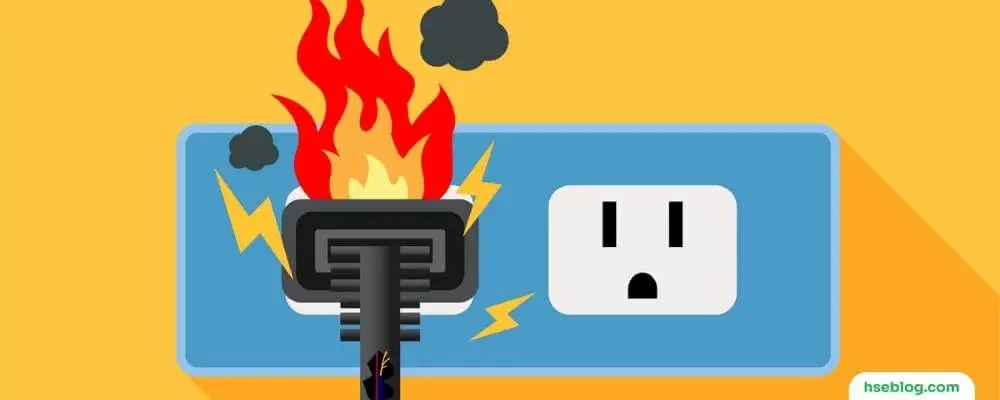
Selecting Extension Cords
Selecting the right extension cord involves several considerations to ensure safe and efficient power distribution for your specific needs:
- Gauge and Wire Type: Choose a cord with the appropriate wire gauge (thickness) for the power demand of your connecting devices. Thicker wires (lower gauge numbers) can handle more current. For heavy-duty appliances, opt for a lower gauge cord.
- Length: Select a cord that is just long enough for your needs. Using an excessively long cord can result in voltage drop, which can cause inefficient operation of connected devices. However, avoid using a too-short cord, as it may cause tension and damage to both the cord and the outlet.
- Power Rating: Ensure the cord’s power rating (in watts or amps) matches or exceeds the total power draw of the connected devices. Overloading a cord beyond its rating can cause overheating and fire hazards.
- Environment Suitability: Choose a cord designed for the environment in which it will be used. Select a cord rated for outdoor use with enhanced insulation and durability for outdoor or wet locations.
- Plug Type and Receptacles: Ensure the plug type of the cord matches your outlet and that the cord has the right number and type of receptacles for the devices you plan to connect.
- Safety Certifications: Opt for cords that bear the mark of a recognized testing laboratory, such as UL (Underwriters Laboratories), certifying that the product meets safety standards.
- GFCI Protection: If you’re using the cord in a potentially wet environment or for outdoor purposes, choose one with built-in GFCI (Ground Fault Circuit Interrupter) protection for added safety against electric shocks.
- Jacket Material: Consider the cord’s jacket material for specific applications – for example, rubber provides good flexibility and durability, while a plastic jacket might be more appropriate for lighter indoor use.
By considering these factors, you can select an extension cord that is safe, efficient, and tailored to your specific requirements.
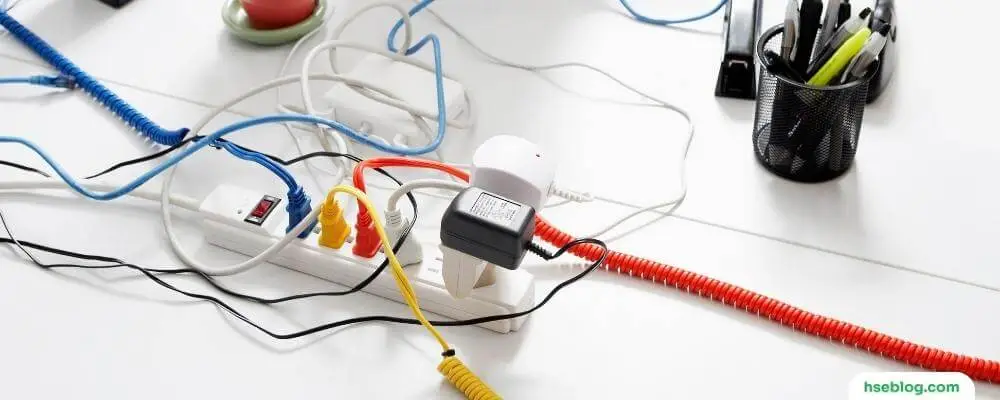
Extension Cord Safety – 20 Tips For Safe Extension Cords Use
Extension cord safety is crucial to prevent electrical hazards and reduce the risk of fires and injuries. Here are some important tips to follow when using extension cords:
1. Inspect Before Use
Before using an extension cord, a comprehensive physical inspection of the cord is vital to avert potential fire risks. Damages such as frayed or exposed wires or insecurely attached plugs may indicate that the cord could become a hazard. It’s crucial to scrutinize the entirety of the cord, not just parts that are immediately visible. Take note of any wear and tear or physical defects, such as loosened or missing insulation, or any cuts or nicks along the cord’s length.
Check the integrity of the plug ends, ensuring they are solidly attached and not broken. Damage to the cord can compromise its safety features and lead to short circuits or overheating, ultimately increasing the risk of fires. If you identify any such damage, refrain from using the cord. Discarding and replacing a faulty cord with a new, undamaged one is far safer.
2. Choose The Right Extension Cord
An appropriate extension cord is crucial for safely and efficiently operating your devices or appliances. Pay attention to three key specifications: the cord’s length, wire gauge (thickness), and power rating (capacity to handle electrical current).
- Firstly, opt for the shortest cord that fulfills your requirements, as longer cords can cause voltage drops which can affect the performance of the devices.
- Secondly, take note of the wire gauge; a lower gauge indicates a thicker wire capable of handling more current – which is essential for heavy-duty appliances.
- Lastly, check the power rating, usually measured in amperes or watts, to ensure it can handle the combined power draw of the devices you plan to connect without overheating.
Utilizing an extension cord that doesn’t meet these criteria can result in the cord overheating, which can damage the connected devices or appliances and also poses a fire risk.
3. Use The Appropriate Cord For The Environment
Employing an extension cord tailored to the environment it will be used in is essential for safety and functionality. When using an extension cord in outdoor spaces or damp locations, choosing one explicitly constructed for such conditions is imperative. Outdoor-rated extension cords are typically fabricated from hard-wearing materials that withstand environmental elements like rain, snow, and temperature fluctuations.
Moreover, they possess added insulation which serves as a safeguard against moisture. This extra protection is crucial as moisture can be a conduit for electricity and may lead to short circuits or electric shocks if a standard cord is used in wet conditions. Therefore, always check for labels or markings indicating the cord is suitable for outdoor use to ensure safety and performance.
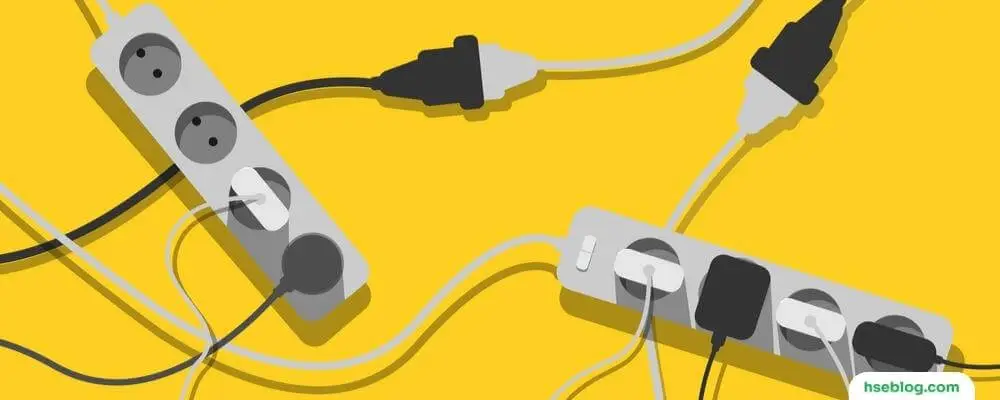
4. Avoid Overloading The Cord
It’s imperative to avoid overburdening an extension cord by ensuring that the total power drawn by the devices or appliances connected doesn’t exceed its maximum power rating, usually indicated in amps or watts. Overloading occurs when the sum of the electrical current required by the connected devices surpasses the cord’s capacity to safely conduct that current. This can lead to the cord heating up excessively, which compromises the integrity of the insulation and can be a precursor to a fire.
Being vigilant about not surpassing the cord’s rated capacity is essential for minimizing the risk of overheating and maintaining a safe environment. This can be achieved by understanding your appliances’ power requirements and ensuring compatibility with the extension cord’s specifications.
5. Unplug properly
When it’s time to disconnect a device or appliance from an extension cord, it’s vital to do so correctly to prevent damage to the cord. The proper method is to firmly grasp the plug and pull it straight out of the socket. Yanking or pulling the cord itself instead of the plug can cause stress on the internal wiring and the connectors, which could lead to them becoming loose or damaged. This, in turn, can create a hazardous situation where the cord may not perform safely, increasing the risk of electrical shorts or fires. By always pulling the plug directly, you help preserve the integrity and safety of the extension cord for continued, reliable use.
6. Don’t daisy-chain extension cords
Refraining from linking multiple extension cords, a practice known as daisy-chaining, is critical for safety. Instead, it’s advisable to use a single extension cord that meets the length requirements for the task at hand. Daisy-chaining can lead to several issues, primarily because it’s easy to overlook the cumulative power draw on the cords, which can result in an overload.
Additionally, the connections between the cords are often not as secure as a single cord and can become loose, creating high resistance points and the potential for arcing or overheating. This not only jeopardizes the functionality of the connected devices but also significantly increases the risk of electrical hazards, including fires. Using a single, appropriately-rated extension cord ensures a more stable and safer electrical connection.
7. Keep cords away from heat sources
It is paramount to exercise caution in keeping extension cords at a safe distance from heat sources like radiators, heaters, or stoves. This is because the intense heat emanating from these sources can degrade the insulation material surrounding the wires in the extension cord. As the insulation weakens, it can lead to exposure of the internal wires, which creates a hazardous situation. Not only does this expose the environment to live electrical conductors, but it can also cause the cord to overheat more easily.
When a compromised cord is near a heat source, the risk of it igniting and causing a fire is significantly heightened. Therefore, ensuring that extension cords are routed away from and not near heat sources is a critical safety practice.
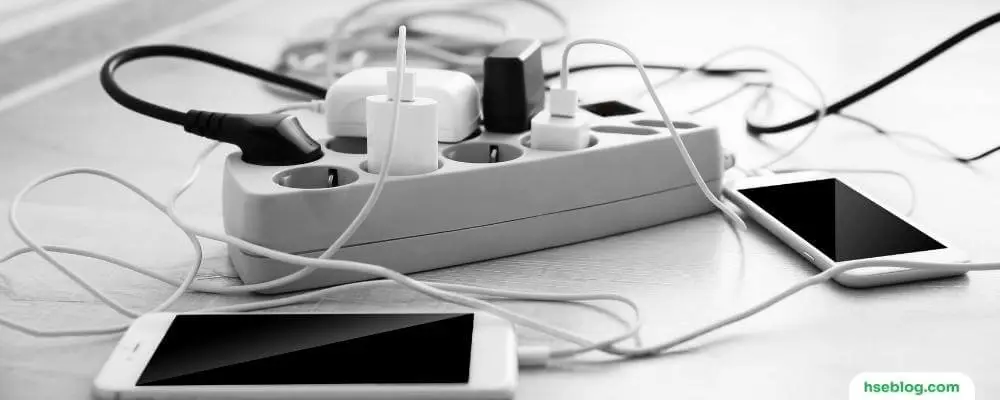
8. Do not run cords under carpets or rugs
It is crucial not to place extension cords under carpets or rugs. Concealing cords in this manner impedes the dissipation of heat that naturally builds up during use, and the trapped heat can cause the cord to overheat. Overheating might result in the cord’s insulation degradation, heightening the risk of electrical fires.
Additionally, cords underfoot and obscured by carpets or rugs can create an unforeseen tripping hazard. The concealed cord can also be unknowingly subjected to pinches or excessive wear due to foot traffic, damaging the cord. To minimize these risks, it’s advisable to route the cord through open spaces where it remains visible and free from obstructions or compression, thereby promoting safe use.
9. Store cords properly
Proper storage of extension cords is key to prolonging their lifespan and maintaining safety. When an extension cord is not in use, it should be coiled loosely in a circular or figure-eight shape to prevent putting undue stress on the internal wiring. Tightly wrapping or bundling the cords can lead to kinks or potentially damage the internal wiring, which may create electrical hazards in the future.
It is also important to store the coiled cords in a cool and dry environment. A cool environment prevents residual heat from degrading the cord’s insulation, and a dry environment protects against moisture, which could also compromise the cord’s insulation and create a safety hazard. Proper storage practices ensure that the extension cords remain in good condition and are safe to use when needed.
10. Follow the manufacturer’s instructions
Adhering to the manufacturer’s instructions and guidelines accompanying the extension cord is indispensable for safe and effective usage. These instructions are tailored to the specific design and capabilities of the cord and often encompass vital safety recommendations and operating procedures. For instance, the manufacturer may stipulate the maximum power rating, suggest suitable environments for use, or provide guidance on proper coiling and storage.
Ignoring these guidelines can lead to misuse of the cord, which may not only damage the cord or connected devices and pose serious safety risks such as electrical shocks or fire. Following the manufacturer’s instructions, you are taking informed steps to utilize the extension cord within its designed parameters, ensuring safety and performance.
11. Mark Of An Independent Testing Laboratory
One essential precaution to mitigate electrical accidents, which are alarmingly prevalent, is to verify that all electrical equipment and extension cords are endorsed with the mark of an independent testing laboratory, such as UL (Underwriters Laboratories). UL is a venerable nonprofit entity that rigorously tests and certifies products for safety compliance. The UL mark on an extension cord or electrical device signifies that the product has undergone scrupulous testing and adheres to stringent safety standards, giving users confidence in its safety and reliability.
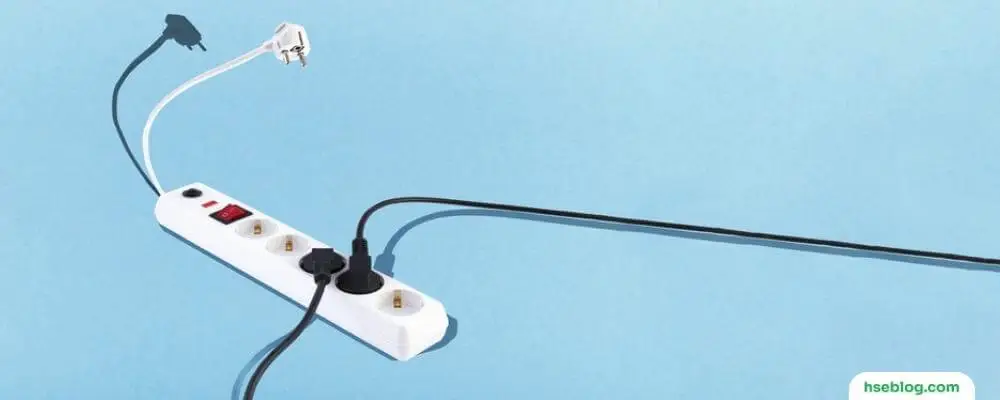
12. Use GFCI (Ground Fault Circuit Interrupter) Protection
Utilizing GFCI (Ground Fault Circuit Interrupter) protection when using extension cords is a necessary safety measure, especially in environments with a water or moisture exposure risk. A GFCI is designed to rapidly cut off the electrical supply when it detects an imbalance between the incoming and outgoing current, which indicates a ground fault (such as a current flowing through water or a person).
This fast-acting mechanism significantly reduces the risk of electric shock and electrocution. Incorporating GFCI protection through a GFCI-protected outlet or a GFCI adapter on the extension cord is especially crucial in places like bathrooms, kitchens, and outdoor settings, where the interplay between electricity and moisture is most perilous.
13. Use Three-Wire Extension Cords
In construction sites, where the environment is often rugged and poses various electrical hazards, employing three-wire extension cords is a critical safety practice. A three-wire extension cord comprises three conductors: a live, neutral, and ground wire. Including the ground, wire is vital as it provides an alternative path for excess current to flow safely into the ground in case of a short circuit or a fault.
This grounding mechanism significantly reduces the risk of electric shocks, which can be particularly hazardous in construction settings where equipment and workers may come into contact with water or conductive materials. Utilizing three-wire extension cords ensures temporary power is distributed safely from the source to the tools and equipment used.
14. Don’t Run Them Through Doorways, Holes In Ceilings, Walls, Or Floors
Extension cords are incredibly useful for providing power to areas that lack proximate outlets, but employing them responsibly is paramount to prevent damage or fire hazards. It’s imperative to avoid running extension cords through doorways or holes in ceilings, walls, or floors. Passing cords through these constricted spaces can lead to their insulation being pinched or abraded, compromising the cord’s integrity and posing a fire risk.
Additionally, it can create a tripping hazard which could lead to injuries. Furthermore, it’s essential to use cords rated for the specific power requirements of the devices you intend to use and to be mindful not to overload the outlets, as this could also result in overheating and fire hazards.
15. Do Not Force A Plug Into An Outlet
Resisting the temptation to exert force when plugging an appliance into an outlet is vital for safety. When a plug doesn’t fit easily, forcing it into the outlet can be hazardous. This action can cause damage to both the plug and the outlet’s internal wiring. Damaged wiring can result in poor electrical connections, which can cause overheating or sparking – conditions ripe for electrical fires. It’s important to ensure that plugs and outlets are compatible and to insert plugs gently and firmly without using excessive force, to maintain the integrity of the electrical connection and prevent dangerous situations.
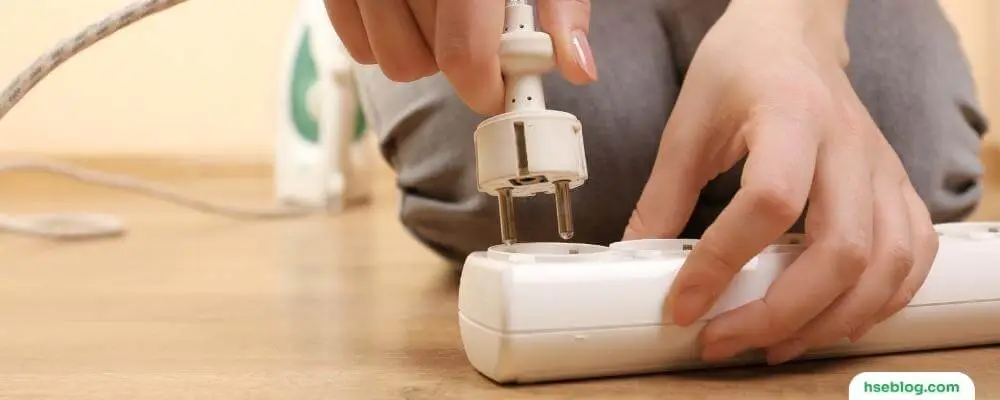
Additional Extension Cord Safety
- Ensure Full Insertion of Cord Into Outlet: To avoid electrical hazards, ensure the extension cord is securely and fully inserted into the outlet. Partial insertion may cause the cord to become loose, leading to arcing, which can degrade the wires and create a fire hazard.
- Do Replace Outlets with Loose Fitting Plugs: A plug that does not fit snugly into an outlet can cause overheating due to a poor electrical connection, creating a fire hazard. Additionally, it can damage the appliance cord over time. Replace such outlets to ensure a secure fit.
- Do Keep Cords Away from Water: Water conducts electricity, and it’s vital to ensure that extension cords do not come into contact with moisture to prevent electric shocks.
- Do Keep Cords Out of Reach of Children and Pets: Children and animals may inadvertently chew on or play with extension cords. Keep cords away from them to avoid the risk of electric shock.
- Do Pull on the Plug, Not the Cord: When unplugging, always pull on the plug rather than the cord to avoid damaging the cord’s internal wiring, which can lead to electrical hazards.
- Do Unplug Cords When Not in Use: Extension cords should be unplugged when not in use to avoid the risk of fire from a damaged or frayed cord and to save energy. They are not meant to be permanent fixtures and should be stored properly when not in use.
- Do Use Safety Covers on Unused Outlets: Place safety covers on unused receptacle outlets of extension cords to eliminate the risk of accidental contact with live wires, preventing electrocution.
- Do Not Use a Wet Extension Cord: Combining water and electricity is extremely dangerous. Never use an extension cord when wet, as this can lead to electric shocks or short circuits that can cause fires.
Conclusion
Extension cord safety is paramount to preventing electrical accidents and ensuring the efficient operation of appliances and devices. Individuals can significantly mitigate risks by meticulously inspecting cords for damage, using the correct type and length, ensuring full insertion into outlets, avoiding overloading, and being mindful of the environment in which they are used.
Additionally, adopting practices such as not running cords through doorways or under carpets, keeping them away from heat sources, water, children, and pets, and utilizing safety features like GFCI protection and safety covers, contribute to creating a safer environment. Lastly, selecting cords with appropriate specifications and safety certifications and proper storage when not in use encompass the holistic approach to extension cord safety. Through these 20 tips, users can harness the convenience of extension cords while upholding rigorous safety standards.

